Transportation Electrification: Beyond Electric Cars
It’s not just cars becoming battery-powered. Let’s take a journey through the world of non-mainstream EVs.
Electrification has shown real hope of reducing the transportation sector's carbon dioxide (CO2) emissions. While the shift in ordinary passenger vehicles is gaining traction, it isn’t the only category of electric vehicle (EV) under development.
Aptera solar electric vehicle. Image courtesy of Aptera Motors Corp.
Transportation is undergoing a fundamental shift through the electrification of all types of vehicles.
Benefits Beyond Emissions Reduction
Transportation electrification extends beyond emission reduction, offering a multitude of benefits, including:
- Improved energy efficiency: EVs convert over 77 percent of the electrical energy from the grid to power the wheels, compared to only 12–30 percent of the energy from fossil fuels that power a gasoline vehicle.
- Reduced noise pollution: Electric vehicles operate quietly, creating a more peaceful and livable environment.
- Lower operating costs: EVs have lower maintenance costs and are not subject to gasoline price fluctuations.
- Particulate and smog emission reduction: Beyond planet-warming CO2, gasoline and diesel internal combustion engines emit various exhaust gases, such as oxides of nitrogen and particulates, that have been shown to cause respiratory illnesses. The switch to electrification will have significant health benefits.
Early Electric Vehicles
Before the Nissan Leaf (2010) and the Tesla Model S (2012) jump-started the modern era of EVs, electrification had its ups and downs. In the earliest days of the automobile, gasoline, steam, and battery electric power shared the beginnings of the automotive marketplace. Electrics had an advantage in that they were quiet and didn’t require difficult and potentially dangerous hand cranking to start. The limited range of the battery technology of the day limited them to primarily city usage. Thanks to the electric self-starter, first seen on a Cadillac in 1912, gasoline-powered vehicles took over, and the first age of EVs effectively ended by 1920.
From the early 1930s beyond the end of the 1960s, more than a dozen companies in England built electrically powered “milk floats” for the home delivery of fresh milk and dairy products. These low-powered, low-speed delivery trucks typically replaced horse-drawn wagons and were a common sight across the United Kingdom.
Early electric golf cart. Image used courtesy of Club Car
In 1951, the Marketeer Company, located in Redlands, California, began production of an electric battery-powered golf cart. E-Z-Go joined them in 1954, Cushman in 1955, Club Car in 1958, Taylor-Dunn in 1961, and motorcycle giant Harley-Davidson in 1963. It is quite likely that until recently, the electric vehicle most people first experienced was a golf cart, and they are still popular in neighborhoods and retirement communities as a practical means of transportation.
Electrically powered forklifts were first developed before World War II and joined diesel and propane-powered industrial machinery in various configurations. Battery-powered forklifts have the advantage of not producing harmful exhaust emissions and can therefore be used inside buildings and warehouses without concern about the buildup of toxic gases while in operation.
The Alternative EV Landscape
Although electrification is also changing the marine and aviation industries, for now, let’s just consider what’s happening on land. We have assembled some of the more interesting innovations and concepts in alternative EVs we might see in the future.
Passenger Vehicles: Out Front in the Electric Revolution
Passenger cars have been at the forefront of the EV revolution, with automakers beginning to introduce a diverse range of electric models to cater to varying needs and preferences. From compact city cars to practical people movers, luxury sedans, a range of SUVs, and electrified pickup trucks, EVs are no longer confined to a single category.
Electric Microcars for City Travel
While most EV manufacturers are building luxury sedans or mainstream SUVs, a handful of companies worldwide are building tiny electric-powered cars primarily suited to city and urban travel. Fifteen years ago, U.S.-based Aptera decided to make a small, light, and highly aerodynamically efficient three-wheel vehicle. Aptera started with a gasoline engine but has since transitioned to battery power and recently announced that solar power is the company’s way forward.
Small and light, the Aptera could range up to 1,000 miles on a 100-kWh battery pack. Pricing is said to start above $26,000, and the company plans a production facility near San Diego, California, where it will build the vehicle’s carbon fiber bodywork. Financial issues, insufficient investments, drama, and intrigue have delayed the production startup repeatedly over Aptera’s 15-year history.
Three-wheeled electric roadster. Image used courtesy of Shockwave Motors
Another U.S. startup that wants to build a commuter EV is Tennessee-based Shockwave Motors. The company’s Defiant EV3 Electric Roadster is a hardtop/convertible that can seat three people. The battery is located to allow easy access and provides a range of about 100 miles. The three-wheel design combines 1940s styling with a modern electric drivetrain, achieving an effect that differs from any other vehicle on the road.
Microlino car. Image used courtesy of Microlino
In Europe, a Swiss company called Microlino has introduced its L7e light electric vehicle loosely based upon the shape of the 1950s BMW Isetta gasoline-powered microcar. With a top speed of 55 mph and a range up to 143 miles with its largest battery option, the tiny size of the L7e makes it perfect for challenging parking environments in major cities. With a steel and aluminum unit body construction, the tiny EV can carry two passengers and a surprising amount of luggage. Production has started in Turin, Italy, and prices start at 15,000 euros (about $16,175 U.S.).
Electrified Trucks and SUVs
The electrification trend is not limited to passenger cars but is also transforming the world of trucks and SUVs. Automakers are developing powerful electric trucks and SUVs with impressive towing capabilities, extended range, and off-road prowess, challenging the conventional perception of electric vehicles.
Commercial Vehicles: Efficiency and Sustainability
The EV revolution extends to commercial vehicles, including buses, delivery vans, and heavy-duty trucks. Electric commercial vehicles offer significant benefits, such as reduced emissions, lower operating costs, and quieter operation. This makes them ideal for urban environments and reducing the environmental impact of transportation.
Amazon electric delivery van. Image courtesy of Amazon
An example of electrified delivery is a partnership between Amazon and electric truck maker Rivian to bring 100,000 electric delivery trucks into use in the U.S. by 2030. Amazon started using its electric delivery vans in the summer of 2022 and now has over 10,000 used across the U.S. The company has also begun using the vehicles in Europe.
General Motors has developed an electric delivery van through Brightdrop. Using the GM Ultium battery platform, the delivery van has a low step-in height and can achieve a range of up to 250 miles between charges.
Tesla semi-truck. Image used courtesy of Tesla
On the big-truck scale, companies like Freightliner, Volvo, and Tesla are building over-the-road semi-trucks to allow long-distance trucking without diesel exhaust emissions.
Electric buses are rapidly becoming popular. School buses and city buses can operate without the emissions of diesel particulates that contribute to smog and can cause respiratory ailments, particularly among children. According to the International Energy Agency, almost 66,000 electric buses and about 60,000 medium- and heavy-duty trucks were sold in 2022, representing about 4.5 percent of all bus sales and making up as much as 1.2 percent of worldwide truck sales.
Two-Wheelers: Electrifying Urban Mobility
Electric motorcycles and scooters are gaining popularity as eco-friendly and agile modes of transportation in urban areas. These electric two-wheelers offer a convenient and emission-free solution for commuting and short-distance travel.
Harley Davidson’s electric motorcycle line, LiveWire. Image used courtesy of LiveWire
U.S. electric motorcycle maker Zero has been building battery-powered motorcycles since 2010. It has a range of street and off-road motorcycles. Italian company Energica has been in operation since 2014 and has specialized in road-racing electric motorcycles, while Harley-Davidson introduced its LiveWire electric motorcycle in 2019.
Almost every bicycle manufacturer globally has at least one electric bike in its lineup as they have become increasingly popular for leisure riders and daily commuters. Specialized versions from smaller manufacturers cater to specific needs. For example, Integral Electrics builds the Maven model of an electric bicycle designed specifically for women and smaller riders.
Electric transport bikes. Image courtesy of Pelican Cycles
Bicycles that can carry cargo are good candidates for electrification. An example is the Pelican Train, from a French startup building a cargo e-bike that can pull one or two electrified trailers behind it with up to 1,100 pounds of payload. Prices start at 4,500 Euros ($4,850 U.S.).
Electric cargo bike. Image used courtesy of Integral Electrics
In New Zealand, the UBCO electric bike has two-wheel drive, thanks to motors that power the front and rear wheels. Initially designed for use in the agricultural industry to reach remote parts of a farm or ranch, the UBCO bike has also been adopted by adventurers who appreciate its go-anywhere performance capabilities.
Perhaps one unexpected use of electric bicycles and motorcycles is with the military. Electrically powered cycles can be recharged using solar panels at forward operating bases, reducing the need for fuel convoys. They are also nearly silent and can cover rough terrain, making them useful for Special Forces teams and their often-covert missions.
Zero MMX. Image courtesy of Zero Motorcycles
Ukrainian forces have put the concept to good use as heavy-duty e-bikes are being used to silently bring anti-tank missiles to the battlefield. After hitting their targets, soldiers can make a fast and silent escape on their electric bikes. The U.S. military has begun using the Zero MMX for its stealth two-wheeler needs.
Challenges and Future Outlook
Despite the significant progress in EV technology, the same challenges, such as range anxiety, charging infrastructure limitations, and initial vehicle costs, remain for non-mainstream EVs as they exist for everyday electric cars. Rapid advancements in battery technology, expanding charging networks, and government incentives are addressing these challenges in every part of the EV spectrum, paving the way for more widespread adoption of EVs of every type.
















